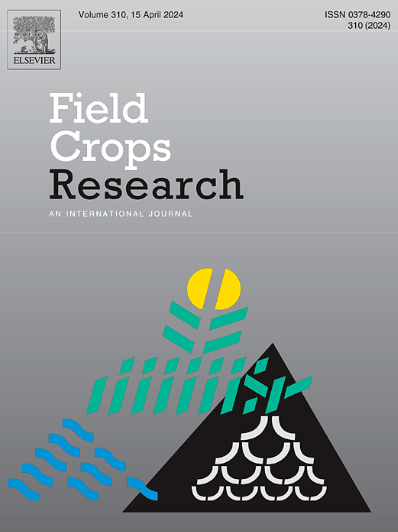Photosynthetic physiology and photosynthate allocation among three tuber types of chufa (Cyperus esculentus L. var. sativus Boeck)
IF 5.6
1区 农林科学
Q1 AGRONOMY
引用次数: 0
Abstract
Context
Chufa (Cyperus esculentus L. var. sativus Boeck) is an emerging oil crop with significant economic, nutritional, and ecological value. However, few studies have examined the photosynthetic physiological function of chufa, C4 type plant, especially regarding the differences among the three tuber types.
Methods
This study investigated the photosynthetic characteristics and photosynthate allocation in 8 accessions of 3 types of tubers (round-tuber, large-tuber, and long-tuber). The field tests were conducted over two years in 2022 and 2023 to explore differences in photosynthetic efficiency and agronomic traits. Besides, one accession with the highest yield was selected from each tuber type for further study on the photosynthate allocation using 13C labeling.
Results
Field tests revealed significant differences among the three tuber types. The long-tuber type of chufa exhibited the lowest photosynthetic capacity, stomatal conductance, tillering number, leaf weight, and 1000-tuber weight, whereas it had a high oil content. The large-tuber type had the largest tuber size and the highest 1000-tuber weight. The round-tuber type showed the highest photosynthetic capacity, gas exchange index, plant height, and yield. The short-term effect of photosynthate transport and distribution followed a similar trend across the three chufa types, with the rate of photosynthate transport being fastest during the tuber initiation stage. However, differences were observed in the long-term effect, indicating distinct distribution strategies among the chufa types, resulting in variations in agronomic traits.
Conclusions
This study revealed distinct differences in photosynthetic physiology and agronomic traits among the three tuber types of chufa. Additionally, it provided insights into the transport and distribution strategies of photosynthates in chufa across different growth stages and tuber types.
Implications
These findings offer valuable theoretical and practical insights for chufa cultivar breeding and cultivation management.
三种块茎型chufa (Cyperus esculentus L. var. sativus Boeck)光合生理及光合作用分配
chufa (Cyperus esculentus L. var. sativus Boeck)是一种新兴的油料作物,具有重要的经济、营养和生态价值。然而,对C4型植物chufa的光合生理功能的研究很少,特别是对三种块茎类型之间的差异研究较少。方法对3种块茎(圆块茎、大块茎和长块茎)8份材料的光合特性和光合作用分配进行了研究。在2022年和2023年进行了为期两年的田间试验,以探索光合效率和农艺性状的差异。在每个块茎类型中选择一个产量最高的接穗,利用13C标记进一步研究光合产物分配。结果田间试验表明,三种块茎类型间存在显著差异。长块茎型荸荠的光合能力、气孔导度、分蘖数、叶重和千块茎重最低,而含油量较高。大块茎型块茎尺寸最大,千块重最高。圆块茎型的光合能力、气体交换指数、株高和产量最高。光合产物运输和分配的短期效应在3种类型间具有相似的趋势,在块茎形成阶段光合产物运输速度最快。然而,长期效应存在差异,表明不同品种间的分配策略不同,从而导致农艺性状的变化。结论三种不同块茎类型的chufa在光合生理和农艺性状上存在明显差异。此外,该研究还揭示了chufa光合产物在不同生长阶段和不同块茎类型间的运输和分配策略。研究结果对荸荠品种选育和栽培管理具有重要的理论和实践意义。
本文章由计算机程序翻译,如有差异,请以英文原文为准。
求助全文
约1分钟内获得全文
求助全文
来源期刊

Field Crops Research
农林科学-农艺学
CiteScore
9.60
自引率
12.10%
发文量
307
审稿时长
46 days
期刊介绍:
Field Crops Research is an international journal publishing scientific articles on:
√ experimental and modelling research at field, farm and landscape levels
on temperate and tropical crops and cropping systems,
with a focus on crop ecology and physiology, agronomy, and plant genetics and breeding.
 求助内容:
求助内容: 应助结果提醒方式:
应助结果提醒方式:


